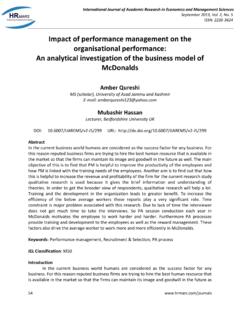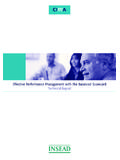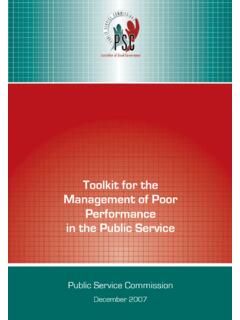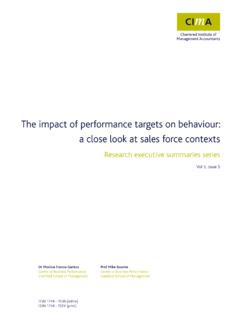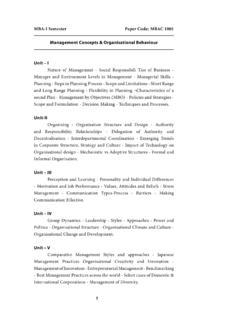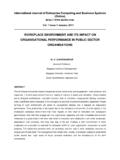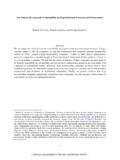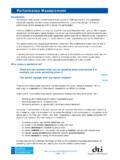Transcription of Performance measurement in facilities management ...
1 Performance measurement in facilities management organisations: Transition from measurement to managementAmaratunga, RDG and Baldry, DTitlePerformance measurement in facilities management organisations: Transition from measurement to managementAuthorsAmaratunga, RDG and Baldry, DTypeConference or Workshop ItemURLThis version is available at: Date2002 USIR is a digital collection of the research output of the University of Salford. Where copyright permits, full text material held in the repository is made freely available online and can be read, downloaded and copied for non commercial private study or research purposes. Please check the manuscript for any further copyright more information, including our policy and submission procedure, pleasecontact the Repository Team at: Performance measurement in facilities management Organisations: Transition from measurement to management Dilanthi Amaratunga & David Baldry Research Centre for the Built and Human Environment, School of Construction and Property management , University of Salford, UK.
2 E-mail: Abstract: facilities create environments for occupants to work effectively within organisations and the Performance of these environments influence the activities that are carried out. Formulation of techniques that are capable of assessing facilities Performance in terms of quality, cost and effectiveness, is critical for Organisational and facilities management advancements. In order to address the emerging assessment needs in the field of facilities management (FM), The Balanced Scorecard, concept is proposed in this paper. This paper speculates that BSC formulates a holistic Performance measurement system that amalgamates facilities management Performance indicators and business/organisational Performance domains. A framework for facilities management Performance measurement is offered based on the case studies carried out, and sets of propositions are suggested which might form a basis for future research in the field.
3 Keywords: facilities management , Performance measurement , Performance management , Balanced Scorecard Background Atkin & Brooks (2000) define facilities management (FM) as, an integrated approach to operating, maintaining, improving and adapting the buildings and infrastructure of an organisation in order to create an environment that strongly supports the primary objectives of that organisation . Thus, FM is viewed as a ..hybrid management discipline that combines people, property and process management expertise to provide vital services in support of the organisation (Then, 1999). FM is defined in various ways, whilst the emphasis remains the same: the management of interaction between the physical environment and humans to enhance the organisational effectiveness (Gagendran,2000). The environment created for the occupants of a facility influence the Performance of the activities carried out in that facility (Gagendran, 2000).
4 Hence, organisations in general desire facilities that are comfortable to occupy, cost effective and efficient to run, and those facilities to remain as added value assets (Douglas, 1996). Surveys by Debenham Tewson Research (1992). Graham Bannock & Partners (1994), Workplace management (1996) and Arthur Anderson (1995) reveal that only on rare occasions do facilities receives explicit attention, and facilities are generally viewed as more of a cost rather than a strategic resource (cited in Then (1999)). This has resulted in facilities managers missing the opportunity to manage the environment in which they operate for competitive advantage. Therefore, any attempt that can show a connection between quality, cost and productivity, offers a useful lever in advancing the facilities Performance and the facilities management discipline (Leifer, 1998) (cited in Gagendran, 2000).
5 If organisations are able to measure the Performance Performance measurement in facilities management Organisations: Transition from measurement to management Amaratunga, D. and Baldry, D. 207 outcomes of their facilities they will be convinced to pay more attention to facilities related resources. facilities and organisational management facilities and organisational management domains have only marginal interactions in the past, and Performance measurement methods from both these domains have continued to neglect the other perspective in their measurement , until the complex business environment urges an intensive dialogue between them (Gagendran, 2000). To this effect, research reported in this paper attempts to conceptualise a Performance measurement system which would integrate both the business and facilities domain, and which intends to develop a method for meaningfully measuring facilities Performance .
6 As suggested by Gagendran (2000), this will enable improved utilisation of resources by organisations and optimum use of the facility to gain competitive advantage. Performance measurement in FM: current thinking It is worth noting that there is no universal agreement on the definition of Performance (Avkiran, 1997). However, Hronec (1993) defines Performance measurement as: a quantification of how well the activities within a process or the outputs of a process achieve a specified goal . In simple terms, Performance is achievement against intention (Gagendran, 2000). Hronec (1993) lists four potential benefits that can arise as a result of having an appropriate Performance measurement system: satisfying customers; monitoring progress; benchmarking processes and activities; and driving change.
7 The emphasis on promoting customer satisfaction and driving change in accordance with the response to external pressures from an increasingly global competitive marketplace, while the emphasis on monitoring progress and benchmarking is a clear reflection of the culture promoting continuous improvement, driven from both within and outside the organisation (Then, 1996). The development of Performance measurement within the context of business management is important in that it sets the background against which senior management within organisations will evaluate the current Performance and contribution of their facilities services in fulfilling corporate objectives. Even in FM environments, where Performance measurement was not adequately addressed, the acceptance of Performance measurement is growing. As Grimshaw and Keeffe (1992) stated: A link exists between the physical environment and the operational efficiency of the organisation.
8 The need for FM Performance measurement systems has already been emphasised by identifying FM as a business resource (Hinks and Hanson,1998; Alexander, 1996a; Then, 1999; Madeley, 1996; Amaratunga and Baldry, 2000). Today s organisations constantly review the composition of their core business and the way it operates (Royal Institution of Chartered Surveyors, 1993). Therefore, clear attention must be paid both to the effective maintenance of support systems and the culture of the organisation. Tranfield and Akhlaghi, (1995) emphasised that FM is an important emerging business sector with an annual size well into tens of billions of pounds in the UK. The FM budget of an organisation can often require thirty to forty per cent of total organisational expenditure, second only in cost to payroll (Williams, 1994).
9 Therefore, good Performance in FM is essential. Performance measurement in facilities management Organisations: Transition from measurement to management Amaratunga, D. and Baldry, D. 208 In the research described in this paper, it was found out that FM managers no longer reject FM Performance measurement and further acknowledge the benefits of their various measurement procedures. Application of the Balanced Scorecard in the facilities management Domain What Performance really means and to be able to measure it are the most crucial things to be understood to embark on a Performance measurement exercise (Gagendran, 2000). Numerous and different approaches to facilities Performance measurement have been developed: Operating costs and Benchmarking (cited in Featherstone, 1999); BIFM measurement protocol (BIFM, 1997); Post-Occupancy Evaluation (Preiser et al, 1988); Hierarchical system of Performance indicators (Belcher, 1997); Input versus output based Performance measurement (Heavisides & Price, 2001).
10 Although many facilities Performance measurement techniques are available, the focus of most of these is primarily on either technical or financial aspects. Amaratunga and Baldry (2002) comment that most of the facilities related measurement tools are either lead to a great deal of confusion about the reasons for Performance indices and Performance measures or that there are too many Performance indices (especially in terms of cost) in the FM market, looking only at wider issues, which fail to link core business issues with those of facilities . They further argued that Performance measurement techniques available in general management literature haven t been fully transformed into FM literature, emphasising the research need in Performance measurement in FM. This illustrates the present state of complexity in measuring facilities Performance meaningfully.










